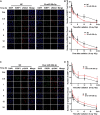miR-29b-3p Increases Radiosensitivity in Stemness Cancer Cells via Modulating Oncogenes Axis
- PMID: 34604239
- PMCID: PMC8481616
- DOI: 10.3389/fcell.2021.741074
miR-29b-3p Increases Radiosensitivity in Stemness Cancer Cells via Modulating Oncogenes Axis
Abstract
Radioresistance conferred by cancer stem cells (CSCs) is the principal cause of the failure of cancer radiotherapy. Eradication of CSCs is a prime therapeutic target and a requirement for effective radiotherapy. Three dimensional (3D) cell-cultured model could mimic the morphology of cells in vivo and induce CSC properties. Emerging evidence suggests that microRNAs (miRNAs) play crucial roles in the regulation of radiosensitivity in cancers. In this study, we aim to investigate the effects of miRNAs on the radiosensitivity of 3D cultured stem-like cells. Using miRNA microarray analysis in 2D and 3D cell culture models, we found that the expression of miR-29b-3p was downregulated in 3D cultured A549 and MCF7 cells compared with monolayer (2D) cells. Clinic data analysis from The Cancer Genome Atlas database exhibited that miR-29b-3p high expression showed significant advantages in lung adenocarcinoma and breast invasive carcinoma patients' prognosis. The subsequent experiments proved that miR-29b-3p overexpression decreased the radioresistance of cells in 3D culture and tumors in vivo through interfering kinetics process of DNA damage repair and inhibiting oncogenes RBL1, PIK3R1, AKT2, and Bcl-2. In addition, miR-29b-3p knockdown enhanced cancer cells invasion and migration capability. MiR-29b-3p overexpression decreased the stemness of 3D cultured cells. In conclusion, our results demonstrate that miR-29b-3p could be a sensitizer of radiation killing in CSC-like cells via inhibiting oncogenes expression. MiR-29b-3p could be a novel therapeutic candidate target for radiotherapy.
Keywords: miR-29b-3p; oncogene axis; radiosensitivity; stemness; three dimensional cultured cells.
Copyright © 2021 Pan, Du, Li, Shen, Liu, Li and Hu.
Conflict of interest statement
The authors declare that the research was conducted in the absence of any commercial or financial relationships that could be construed as a potential conflict of interest.
Figures








Similar articles
-
Mir-29b in Breast Cancer: A Promising Target for Therapeutic Approaches.Diagnostics (Basel). 2022 Sep 2;12(9):2139. doi: 10.3390/diagnostics12092139. Diagnostics (Basel). 2022. PMID: 36140539 Free PMC article. Review.
-
MicroRNA-29b-3p enhances radiosensitivity through modulating WISP1-mediated mitochondrial apoptosis in prostate cancer cells.J Cancer. 2020 Sep 12;11(21):6356-6364. doi: 10.7150/jca.48216. eCollection 2020. J Cancer. 2020. PMID: 33033519 Free PMC article.
-
miR-29b attenuates tumorigenicity and stemness maintenance in human glioblastoma multiforme by directly targeting BCL2L2.Oncotarget. 2015 Jul 30;6(21):18429-44. doi: 10.18632/oncotarget.4384. Oncotarget. 2015. PMID: 26155940 Free PMC article.
-
MiR-29b-3p cooperates with miR-29c-3p to affect the malignant biological behaviors in T-cell acute lymphoblastic leukemia via TFAP2C/GPX1 axis.Biochem Biophys Res Commun. 2020 Jun 25;527(2):511-517. doi: 10.1016/j.bbrc.2020.03.170. Epub 2020 May 15. Biochem Biophys Res Commun. 2020. PMID: 32423796
-
[Expression changes of miRNA-29b-3p and miRNA-34c-3p in lung tissue of rats exposed to silica and A549 cells].Zhonghua Lao Dong Wei Sheng Zhi Ye Bing Za Zhi. 2019 Feb 20;37(2):110-115. doi: 10.3760/cma.j.issn.1001-9391.2019.02.005. Zhonghua Lao Dong Wei Sheng Zhi Ye Bing Za Zhi. 2019. PMID: 30929350 Chinese.
Cited by
-
Unraveling the Potential of miRNAs from CSCs as an Emerging Clinical Tool for Breast Cancer Diagnosis and Prognosis.Int J Mol Sci. 2023 Nov 6;24(21):16010. doi: 10.3390/ijms242116010. Int J Mol Sci. 2023. PMID: 37958993 Free PMC article. Review.
-
Mir-29b in Breast Cancer: A Promising Target for Therapeutic Approaches.Diagnostics (Basel). 2022 Sep 2;12(9):2139. doi: 10.3390/diagnostics12092139. Diagnostics (Basel). 2022. PMID: 36140539 Free PMC article. Review.
-
Cellular and Molecular Profiling of Tumor Microenvironment and Early-Stage Lung Cancer.Int J Mol Sci. 2022 May 11;23(10):5346. doi: 10.3390/ijms23105346. Int J Mol Sci. 2022. PMID: 35628157 Free PMC article.
-
Identification of hub genes and microRNAs with prognostic values in esophageal cancer by integrated analysis.Noncoding RNA Res. 2023 Jun 4;8(3):459-470. doi: 10.1016/j.ncrna.2023.05.009. eCollection 2023 Sep. Noncoding RNA Res. 2023. PMID: 37416747 Free PMC article.
-
Non-coding RNAs modulation in breast cancer radioresponse: mechanisms and therapeutic implications.Strahlenther Onkol. 2025 Jul;201(7):669-678. doi: 10.1007/s00066-024-02317-4. Epub 2024 Nov 15. Strahlenther Onkol. 2025. PMID: 39545960 Review.
References
-
- Asaithamby A., Hu B., Delgado O., Ding L. H., Story M. D., Minna J. D., et al. (2011). Irreparable complex DNA double-strand breaks induce chromosome breakage in organotypic three-dimensional human lung epithelial cell culture. Nucleic Acids Res. 39 5474–5488. 10.1093/nar/gkr149 - DOI - PMC - PubMed
-
- Bartel D. P. (2004). MicroRNAs: genomics, biogenesis, mechanism, and function. Cell 116 281–297. - PubMed
-
- Berghauser Pont L. M. E., Spoor J. K. H., Venkatesan S., Swagemakers S., Kloezeman J. J., Dirven C. M., et al. (2014). The Bcl-2 inhibitor Obatoclax overcomes resistance to histone deacetylase inhibitors SAHA and LBH589 as radiosensitizers in patient-derived glioblastoma stem-like cells. Genes Cancer 5 445–459. 10.18632/genesandcancer.42 - DOI - PMC - PubMed
LinkOut - more resources
Full Text Sources
Miscellaneous

